Talk:List of video game genres/Rewrite
| Video games |
|---|
A video game genre is a specific category of games related by a common gameplay characteristic. Genres are not usually defined by the actual content of the game or its medium of play, but by its common challenge.[1]
Genres may encompass a wide variety of games, leading to even more specific classifications called subgenres. For example, an action game can be classified into many subgenres such as platform games and fighting games. Some games, most notably browser and mobile games, are commonly classified into multiple genres.[1][2]
The following is a list of all commonly-defined video game genres, with short descriptions for individual genres and major subgenres.
Action
Action games emphasize physical challenges that require eye-hand coordination and motor skill to overcome. They center around the player, who is in control of most of the action. Most of the earliest video games were considered action games; today, it is still a vast genre covering all games that involve physical challenges.
Action games are classified many subgenres. Platform games and fighting games are among the best-known subgenres, while shooter games became and continues to be popular in video gaming since the 1990s.[3][4] Action games usually involve elements of twitch gameplay.[3]
Platform games
Platform games (or platformers) are set in a vertical or three-dimensional (3D) environment. Players guide a character through obstacles, jumping on platforms and battling enemies in order to advance. They often involve unrealistic physics and special movement abilities.[2]
Donkey Kong was one of the earliest and best-known platformers; the American gaming press classified it using the term climbing game at the time.[5] Super Mario Bros. was one of the best-selling games of all time; more than 40 million copies were sold (excluding Game Boy Advance and Virtual Console sales).[6] Jumping Flash! introduced 3D graphics to the genre, being the first console platformer to incorporate 3D graphics.[7]
Shooter games

In shooter games (or simply shooters), the player uses ranged weapons to participate in the action, which takes place at a distance.[2] Most shooters involve violent gameplay; lethal weaponry is used to damage opponents. However, some shooters, such as Splatoon, have non-violent objectives.
Shooters, aside from subgenre classifications, can be further classified by their perspective of play. First-person shooters are played within the protagonist's perspective; they often include a heads-up display displaying key information such as the current health of the protagonist.[8][9] In third-person shooters, the protagonist's body can be seen fully; the environment is rendered from a distance.[9] Some shooters incorporate both perspectives.[2]
Since the 1990s, shooters, most notably first-person shooters, have became widely successful in video gaming, accounting for a large percentage of video game sales.[10] Wolfenstein 3D, created by Id Software and released in 1992, was credited for pioneering gameplay and graphics elements incorporated by many other shooters.[11] Also developed by Id and published one year after Wolfenstein 3D's release, Doom is broadly considered to be one of the most influential games in video gaming history.[11] Other successful shooter series include Half-Life, an acclaimed and commercially successful series; and the Call of Duty franchise, with more than 175 million sales across all its titles.[12]
See also
Game interfaces
Game platforms
- Arcade game
- Console game
- Handheld video game
- Massively multiplayer online game
- Mobile game
- Online game
- Personal computer game
Other related topics
References
- ^ a b Adams 2013, ch. 3 § 1.
- ^ a b c d Adams 2013, ch. 3 § 2.
- ^ a b Adams 2014.
- ^ Wolf 2012, p. 572.
- ^ "The Player's Guide to Climbing Games". Electronic Games. 1 (11): 49. January 1983.
- ^ "Mario Sales Data".
- ^ http://www.guinnessworldrecords.com/world-records/first-platformer-in-true-3d
- ^ Call, Whitlock & Voorhees 2012, p. 5.
- ^ a b Adams 2015, p. 39.
- ^ Konnikova, Maria. "Why Gamers Can't Stop Playing First-Person Shooters". The New Yorker. Retrieved 8 November 2015.
- ^ a b Barton & Loguidice 2009, ch. 5.
- ^ Liebl, Matt (April 2015). "Call of Duty franchise surpasses 175 million copies sold". America: Gamezone. Retrieved May 5, 2015.
Bibliography
- Adams, Ernest (2013). Fundamentals of Game Design (3rd ed.). San Francisco: New Riders. ISBN 0-321-92967-5.
{{cite book}}: Invalid|ref=harv(help) - Adams, Ernest (2014). Fundamentals of Action and Arcade Game Design. San Francisco: New Riders. ISBN 0-13-381130-1.
{{cite book}}: Invalid|ref=harv(help) - Adams, Ernest (2015). Fundamentals of Shooter Game Design. San Francisco: New Riders. ISBN 0-13-381094-1.
{{cite book}}: Invalid|ref=harv(help) - Wolf, Mark, J. P. (2012). Encyclopedia of video games : the culture, technology, and art of gaming. Vol. 1. Santa Barbara, California: ABC-CLIO. ISBN 031337936X.
{{cite book}}: Invalid|ref=harv(help)CS1 maint: multiple names: authors list (link) - Rogers, Scott (2014). Level Up! The Guide to Great Video Game Design (2nd ed.). Chichester, England: John Wiley & Sons. ISBN 978-1-118-87716-6.
{{cite book}}: Invalid|ref=harv(help) - Call, Joshua; Whitlock, Katie; Voorhees, Gerald A. (2012). Guns, Grenades, and Grunts: First-Person Shooter Games. London: Bloomsbury Publishing. ISBN 9781441193537.
{{cite book}}: Invalid|ref=harv(help) - Barton, Matt; Loguidice, Bill (2009). Vintage Games. Boston: Focal Press. ISBN 978-0-240-81146-8.
{{cite book}}: Invalid|ref=harv(help)
